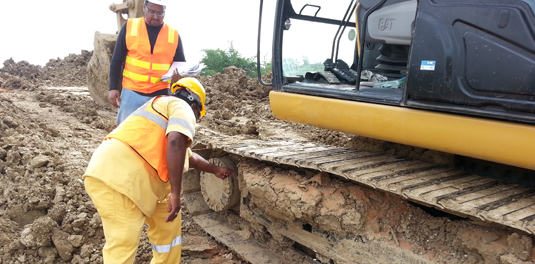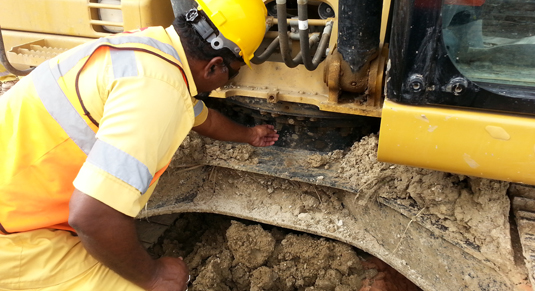Crane, hoisting and lifting equipment inspection from TTCSL ensure that safety and reliability of your equipment and compliance with statutory requirements.
Two facts about powered industrial trucks or heavy equipment is that they have emerged as a necessity and a priority for the ease of work, their use in thousands of workplaces and their continuing role as a significant cause of serious worker injury and death.
The Trinidad & Tobago OSHA places a general duty on employers to "take every precaution reasonable in the circumstances for the protection of a worker" and assigns more specific responsibilities for equipment maintenance, training and supervision. Requirements for powered industrial trucks (heavy equipment), although they are not mentioned specifically, can be found in the regulations made under the OHSA. While meeting these requirements should have prevented most, if not all, of the accidents, compliance was in fact rare. This may be the result of the difficulty that many employers find in applying general requirements of the legislation to particular situations in their workplaces. As a remedy, the owners, operators or shall says users have therefore decided to ensure that they follow the guidelines and adapt all the measures to keep these equipment intact and free from any danger by running regular inspections on them from an experts.

Our Inspection covers and involves the following:
• General safety inspection and maintenance
• Assessment of load-handling capacity
• Competence of person doing load-handling assessment
• Inspection frequency
• Recordkeeping
• Operator competence
• Operating procedures
• Training
Our Services will for Inspection include:
• Maintaining lifting equipment in good condition to prevent mechanical or operational failures. Educating owners, users or employers on preventive maintenance and inspection reports and follow manufacturers’ instructions for recommended maintenance schedules and practices.
• Examining lifting devices to determine their load capacity. If need will conduct the examinations in accordance with the regulations, for example, before using a lifting device for the first time incase if a pre0use equipment has been purchased.
• Ensuring a lifting device is constructed and equipped with suitable ropes, chains, slings and other fittings and maintained to ensure the safety of all workers. Inspectors will ask owners, users or employers about the maintenance and suitability of the equipment in the workplace.
• Inspections will check to ensure workers have the training, knowledge and experience to operate specific lifting devices and that forklift trainees are accompanied by a trained individual. They will also check that supervisors are competent to oversee workers’ operation of these devices.
• Inspections will review training records and question workers and their supervisors on their familiarity with the equipment being used in the workplace, procedures for working in the vicinity of lifting devices, and possible hazards.
• Inspections will check that owners, users or employers are taking the specific reasonable precautions to protect workers who are working in the area of heavy equipment operations along with pedestrians and other occupiers.
Our crane, hoisting and lifting equipment inspection can help you:
• Meet all associated regulatory requirements, with independent inspection carried out in accordance with all applicable regulations, standards and engineering practices
• Assure the safe and proper working capability and condition of your crane or lifting and hoisting equipment
• Maintain the capability and availability of your equipment
• Maximize uptime and planned outages to minimize operational impact
As a part of our expertise we are well equipped to perform statutory and voluntary inspections on cranes, hoisting and lifting equipment across the world. Plus, we can also provide training for operators of cranes and elevating platforms in accordance with local and international standards.

Our crane, hoisting and lifting equipment inspection services include:
• Checking of brakes, clutches, sheaves, and wire rope assemblies
• Design studies and calculation reviews
• Dynamic and static load testing
• Inspection of all the structural load bearing members, including sheaves
• Checking crane girders, rails and columns of overhead cranes to assure structural integrity
• Line level and span crane gantry surveys
• Non-destructive testing (NDT) of load hooks for cracks and visual inspections for distortions
• Operational tests to assure that your unit is functioning properly
• Periodic inspections and inspection prior to use of mechanical, structural, electrical, and safety systems, as well as of wire ropes and chains
• Re-examination of all safety devices
• Regulatory compliance assessments
• Remnant life assessment
• Repairs supervision
Procedure
A complete and comprehensive visual and operational inspection will be made of the entire unit to ensure the unit’s structural integrity and compliance with all applicable standards. To name few items such as wire rope, outriggers, tower, pedestal, main frame, boom sections, sheaves, hydraulic cylinders, pin boss areas, hooks, load blocks, warning placards, controls, safety devices and inspection records.
Each accessible critical weld will be examined visually with the assistance of non-destructive methods using magnetic particle and/or dye penetrant inspection when deemed necessary.
Upon completion of the inspection, Inspector will provide a full report for each unit inspected/tested, and will fully interpret and analyze the results with the company appointed representative. After each unit is inspected, a certificate of inspection or a letter confirming a successful completion of inspection of the unit will be issued.
Inspection of following equipment
• Cranes: Tower Cranes, Mobile Cranes, Overhead Cranes, Pillar Cranes, Mono Rail Cranes
• Trucks: Boom Truck, Dump Truck, Water Truck
• Forklift Truck and Tele-handler
• Skid Steer
• Excavator and Backhoe
• Bulldozer
• Front End Loader
• Road Rollers and Soil and Landfill Compactor
• Aerial Work Platforms
• Manlifts
Programme Approval Criteria:
• Learning Resources
• Assessment Systems
• Internal Verification System
• Staff Resources
• Occupational Safety and Health (OSH)



